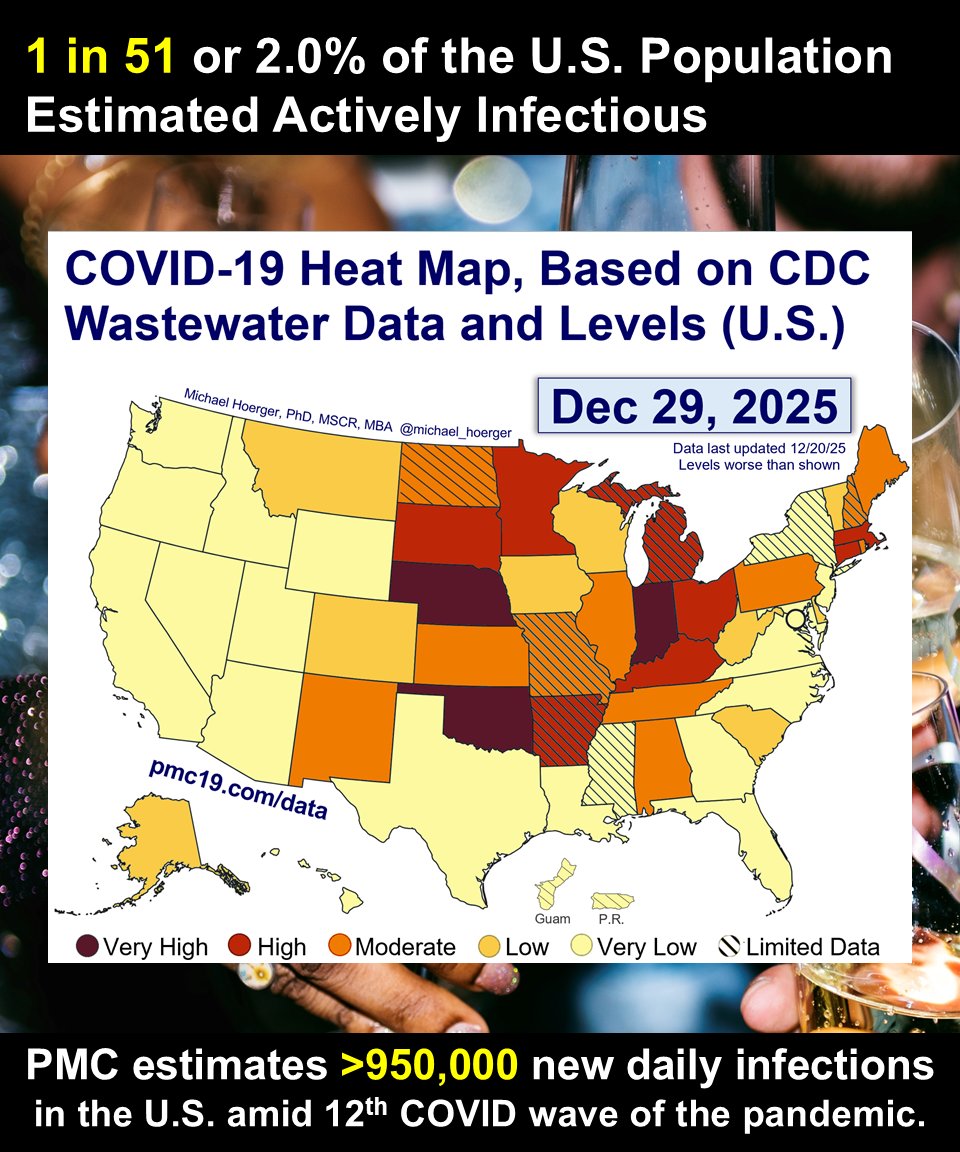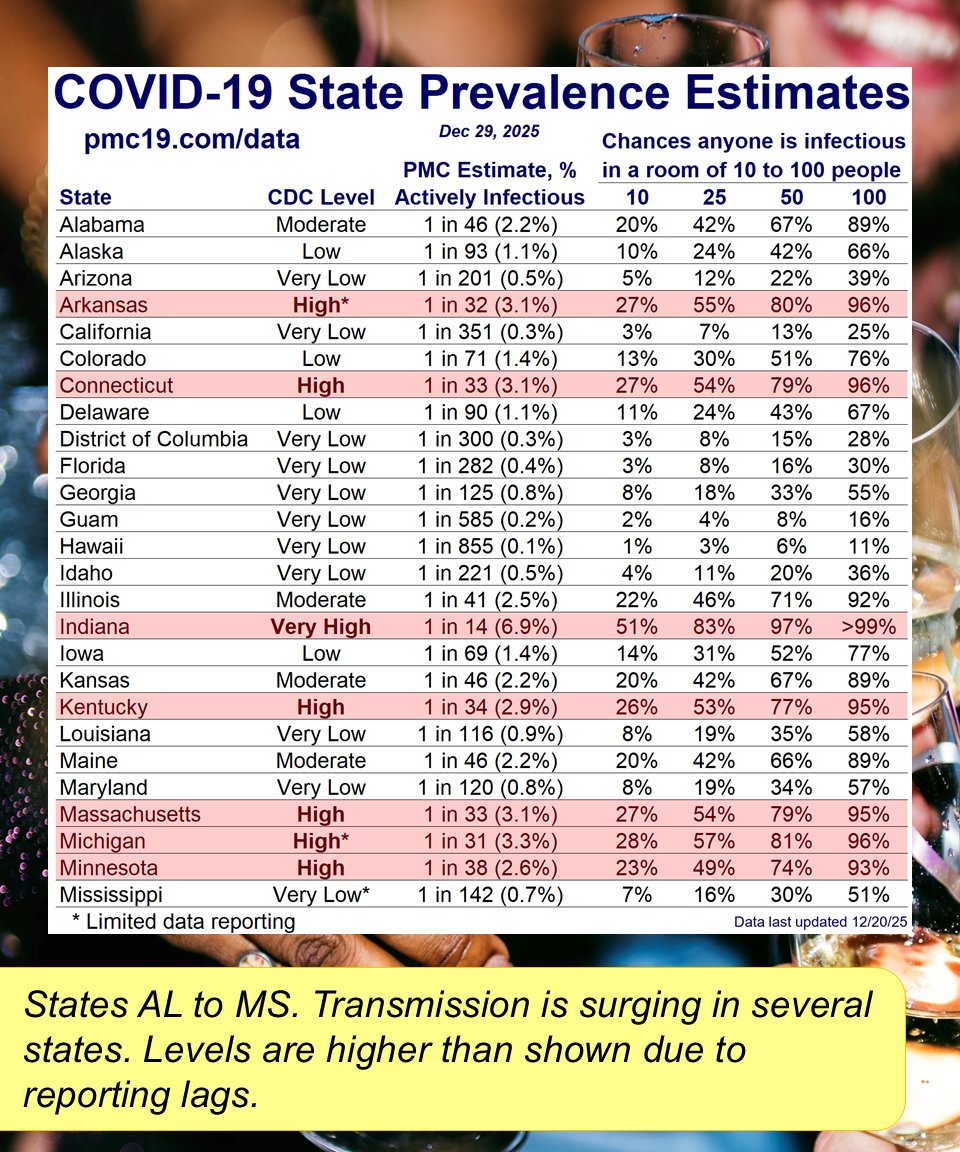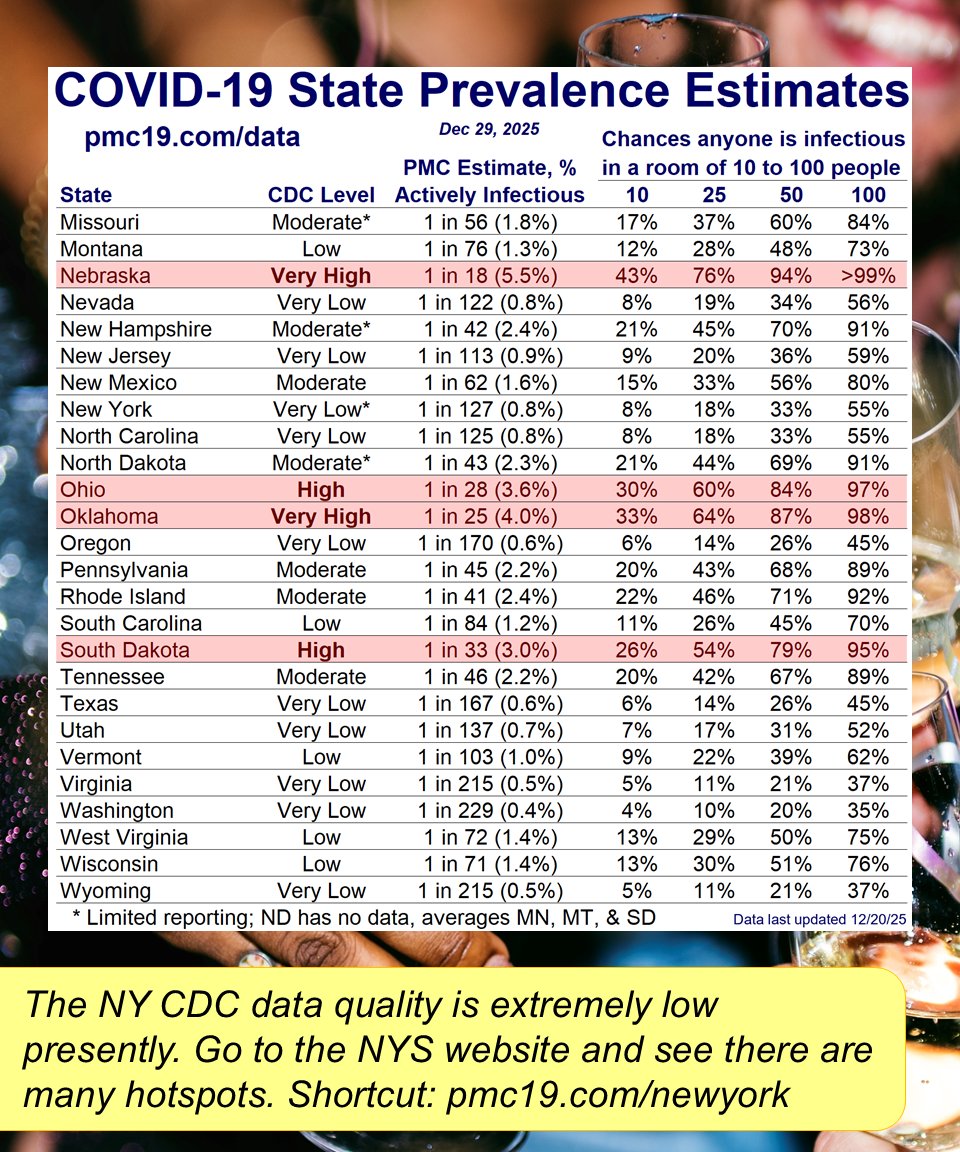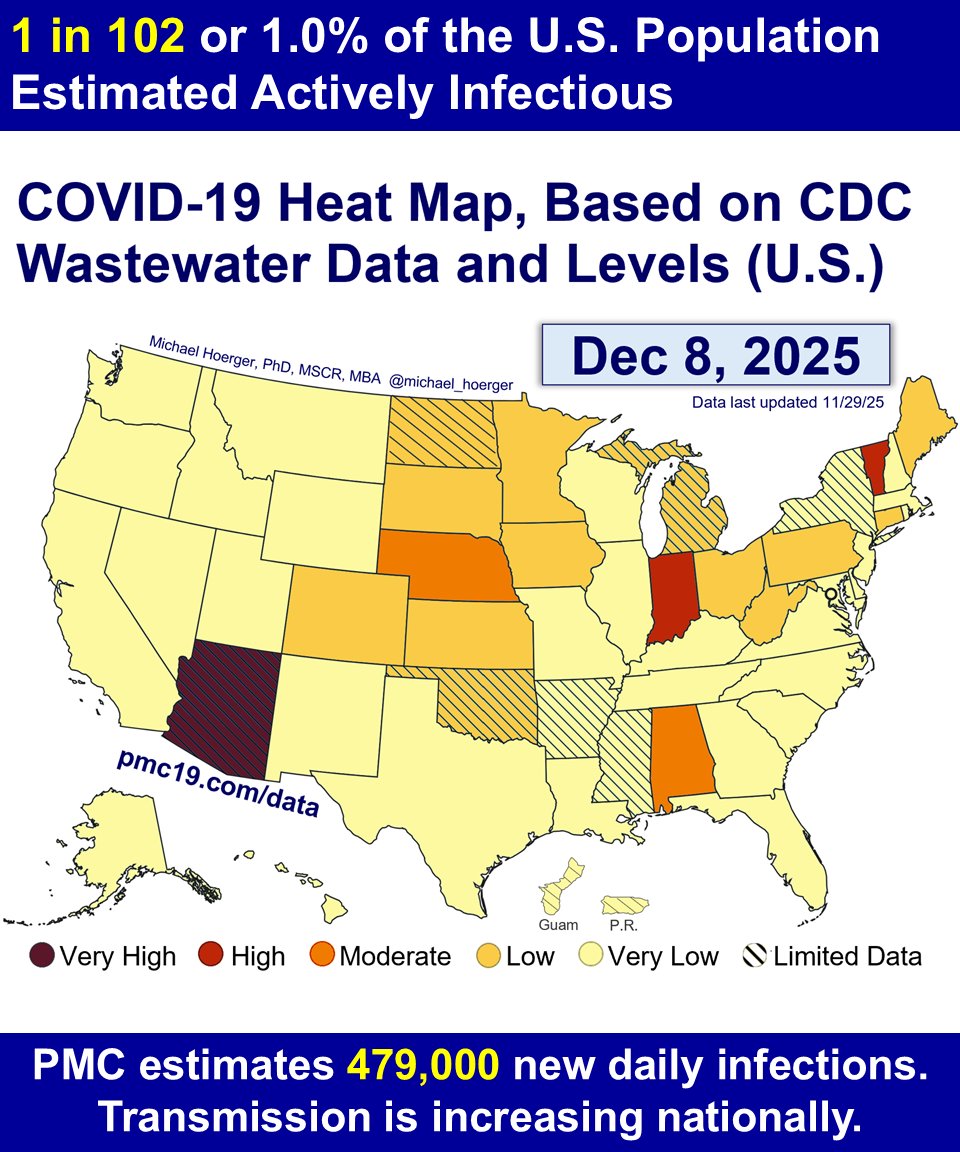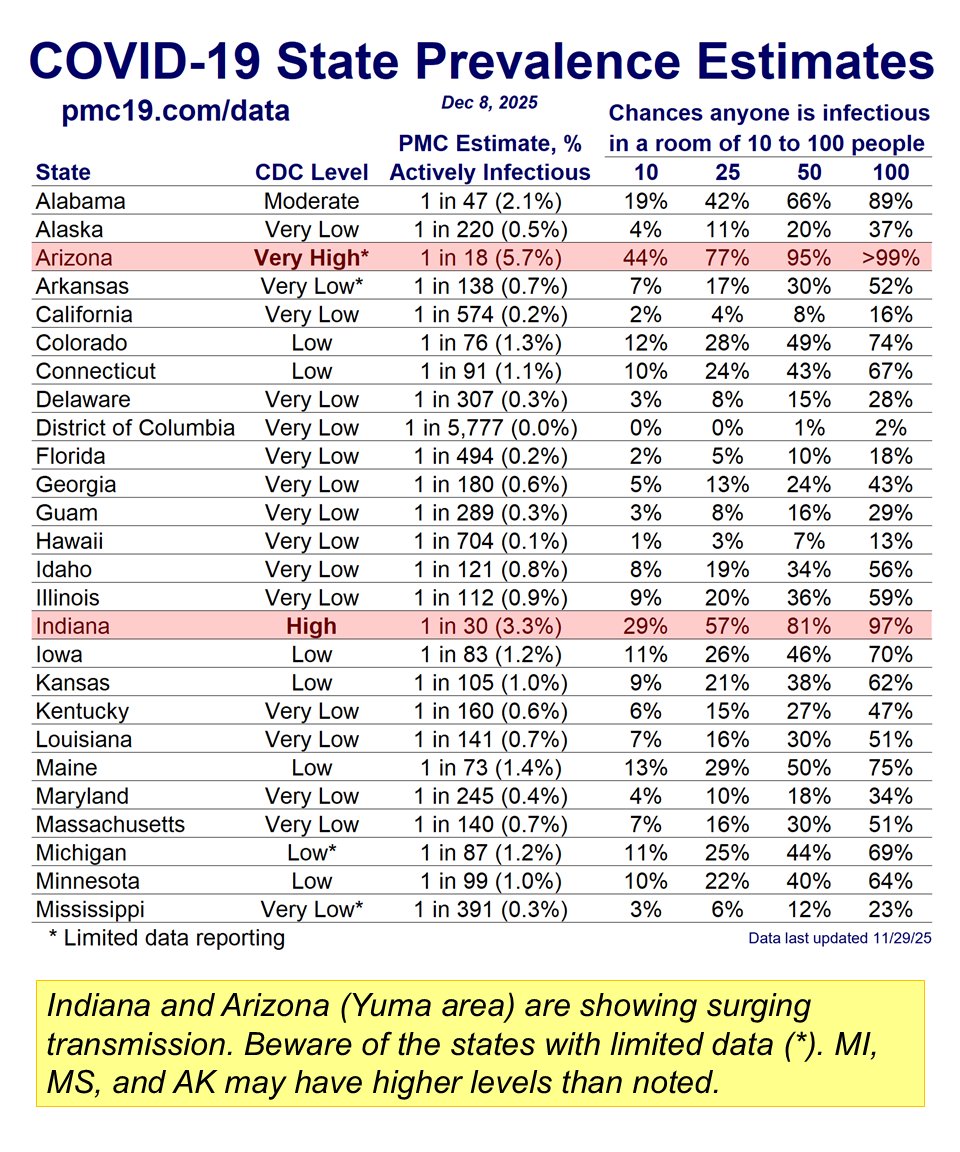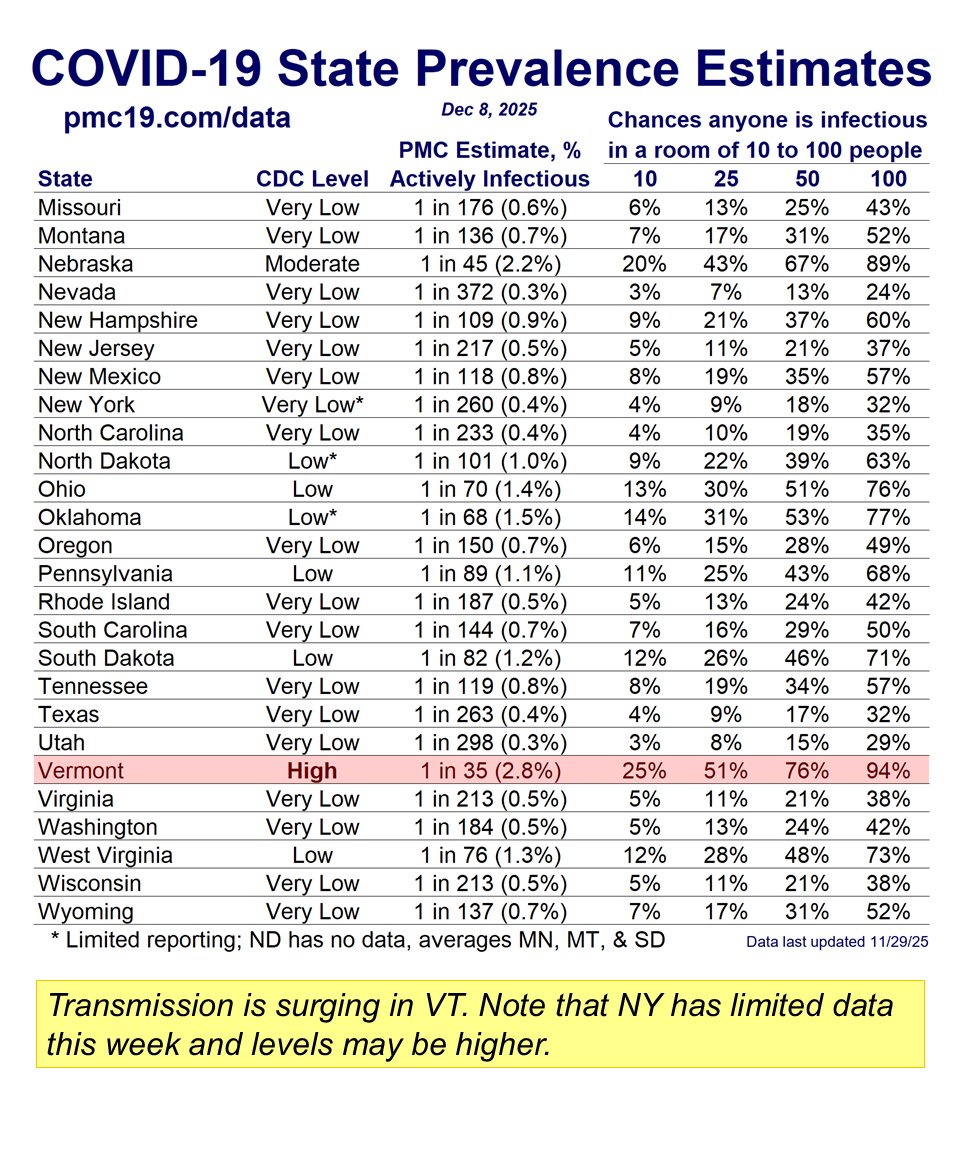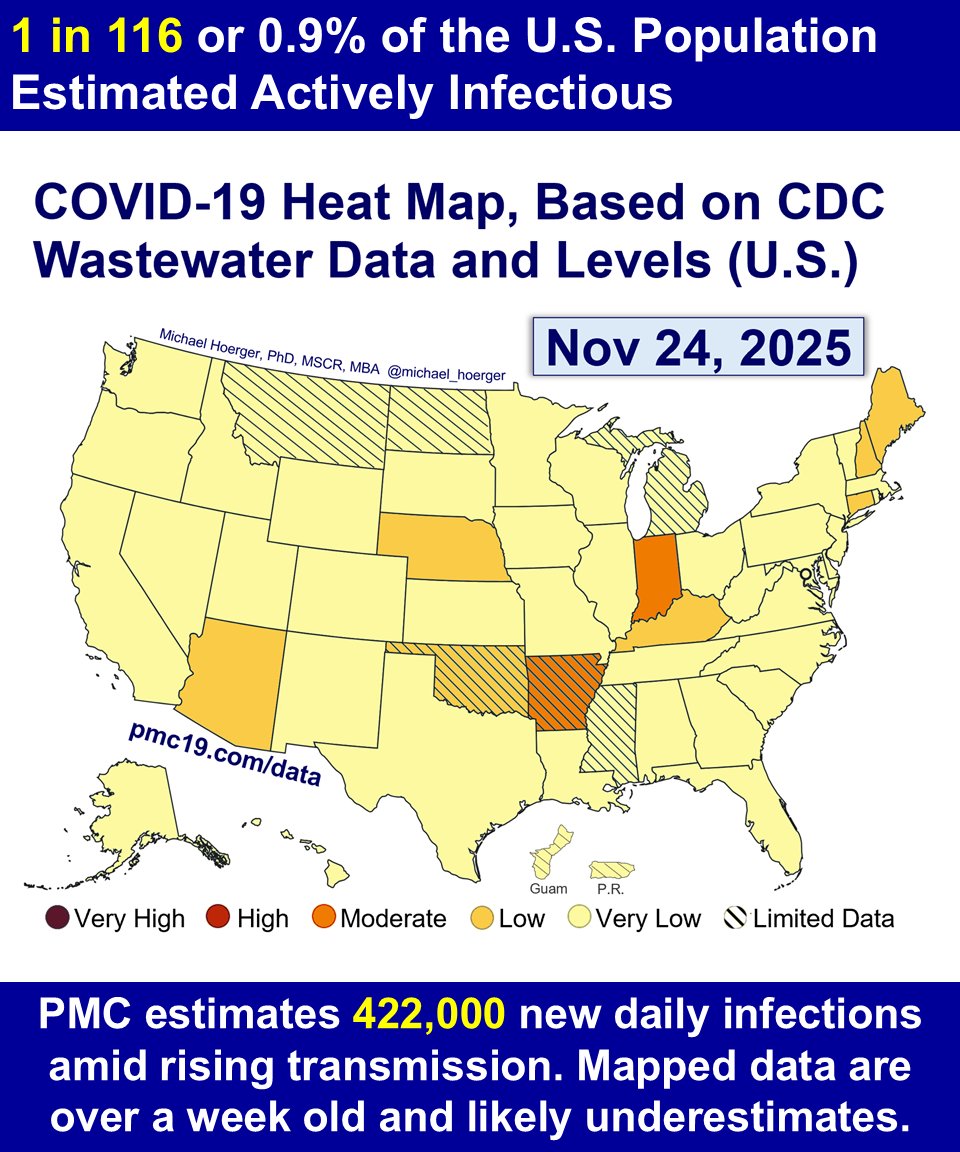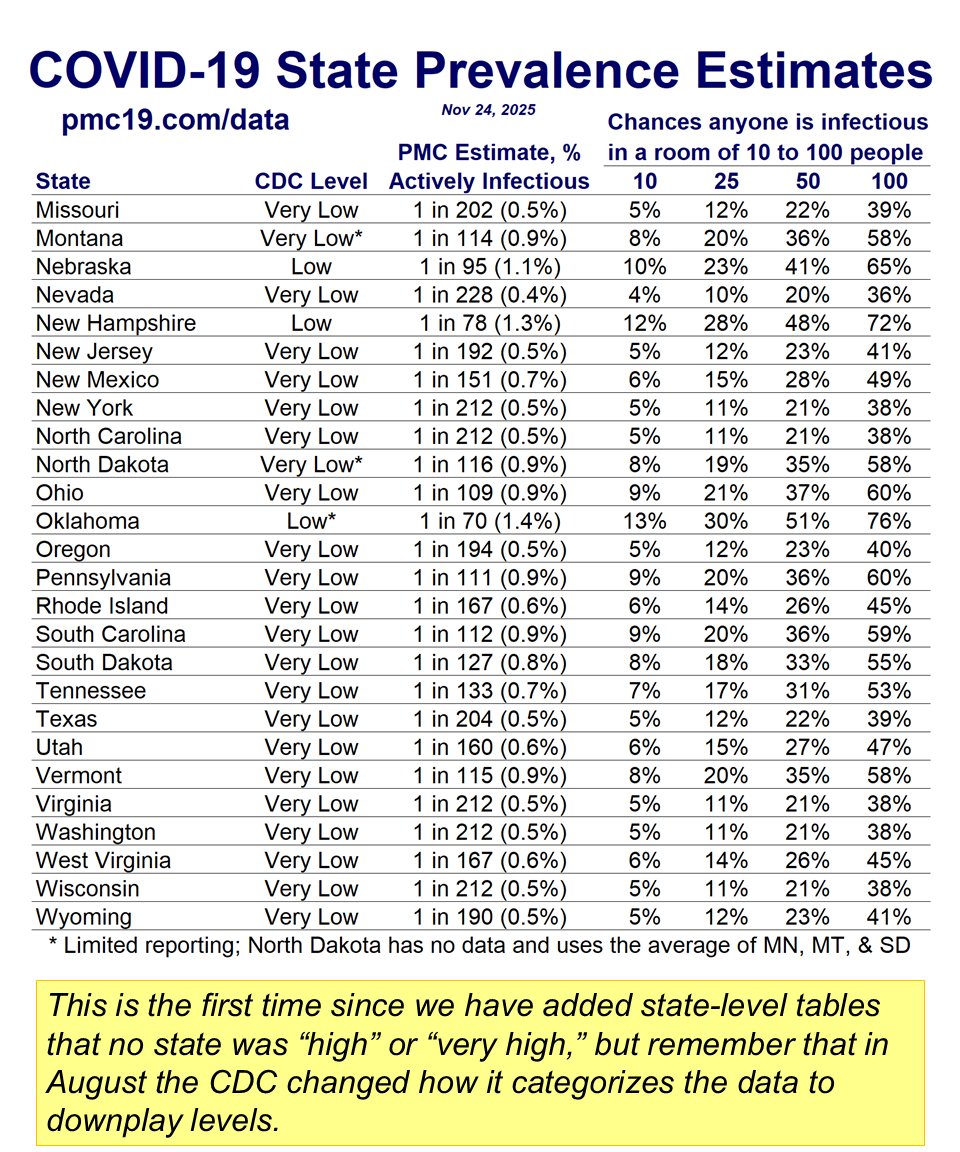BREAKING: Version 2.0 of the PMC COVID-19 Forecasting Model, August 12, 2024
🧵1/7
The U.S. now tops 1.3 million daily infections. 2.8% of the population (1 in 36) are actively infectious.
Deep Dive on Version 2.0 of the Model...
Welcome to version 2.0 of the PMC Model. The “C” in PMC is for Collaborative, and the work to improve this model is grounded in feedback from readers like you over the past year. Thank you for your support.
What’s New?
In short, the new model has substantial data quality improvements by combining multiple data sources for estimating transmission in unique ways that will hopefully increase forecasting accuracy, provide a truer representation of what has happened and is happening during the pandemic, and linkages to some statistics you will find helpful in day-to-day decision making.
Here is a deeper dive into the changes (skip to next section if desired). The new model is designed to provide a “true” picture of what has happened during the pandemic. It integrates three main data sources: the IHME true case estimation model, Biobot SARS-CoV-2 wastewater surveillance data, and the current CDC NWSS SARS-CoV-2 wastewater data. IHME provided a comprehensive case estimation model through April 1, 2023. Biobot was the CDC wastewater subcontractor through last fall and continues to do extensive non-CDC wastewater work. The CDC NWSS data are currently subcontracted with Verily, a subsidiary of Alphabet, which is the parent company of Google. Over the past year, we have seen Biobot scale back their public data and visualizations, and Verily has made steady improvements in their work with the CDC.
We previously relied solely on Biobot for forecasting and a Biobot-IHME data linkage for case estimation. It was a Biobot-heavy model. The current model is not tied strictly to any data set, but rather the PMC’s best estimate of the truth, a true-case model that uses multiple data sources in the spirit of IHME’s original work in this area. Essentially, we link all three data sources, which have been active over different points of the pandemic to derive a composite “PMC” indicator of true levels of transmission. The indicator is weighted based on which data sources were available and their perceived quality at each point in time. We scale this composite PMC indicator to the metric the CDC uses when helpful for comparisons with their website, and scale it with the true case estimates of the IHME otherwise, as true cases are more relevant than arbitrary wastewater metrics.
A great feature of the model is that it continues to integrate real-time data from Biobot and the CDC. From the perspective of Classical Test Theory, this is a huge advantage, as it provides a much more reliable indicator of what is currently happening with transmission. Both sources often make retroactive corrections for the most recent week’s data, sometimes sizable, and pitting the two indicators against one another reduces measurement error on average, which offers vital improvements in forecasting.
What are the Biggest Improvements in the Model?
· Accuracy in Real-Time Data – In integrating two active surveillance data sources, the real-time data will be more accurate. The biggest predictor of next week’s transmission levels, and the shape of how transmission is increasing or decreasing, accelerating or decelerating, is the current week’s real-time data. If the real-time data are off by 5% or 10%, the big-picture take on the forecast will still be reasonable, but a more precise estimate allows for greater accuracy in estimating the height and timing of waves.
· Regional Statistics – We are already integrating some regional data. Like you, we miss the vast and high-quality regional data and visualizations Biobot provided. We are hoping to take back some of those advantages through the new model and will improve them over time.
· Credibility – Although Biobot and CDC have unique strengths and limitations, a clear strength of adding the current CDC data set is that many people prefer to defer to the credibility of the CDC. The PMC model can be characterized fairly as a “CDC-derived case estimation and forecasting model,” which should lend more credence with those who are not deep enough in the weeds to evaluate the data as critically and prefer appeals to authority. We also provide some statistics that will allow you to draw more useful inferences from the CDC website.
What’s the Same in the Current Model?
The analytic assumptions underlying the forecasting model remain the same. It uses regression-based techniques common across all industries, using a combination of historic data (median levels of transmission for each day of the year) and emerging data from the past four weeks to characterize how transmission is growing or shrinking. Holidays and routine patterns of behavior that map on well to a calendar are “baked in” to the historic data. “New variants” and atypical patterns of behavior are baked into the data on recent patterns of transmission. It’s a top-down big picture model.
What are the Biggest Drawbacks of the New Model?
· Disruptions in Longitudinal Comparisons – You will notice some inconsistencies between the current and prior model that use additional data to form more accurate estimates, which is sometimes frustrating. A few examples. In the early pandemic, we estimated cases linking Biobot to IHME case estimates. Biobot transmission estimates were a bit “hotter” than others during that time period, the IHME estimates “cooler.” Our composite model depicts each of the first 4 waves somewhat smaller, which we believe provides a better picture of the “truth” as we can estimate it, but it is annoying psychologically to re-envision what has happened. This also throws off some of the big-picture statistics; for example, as of August 12, 2024, we estimate that Americans have had about 3.3 infections on average. A few months ago, we estimated nearly 3.5, so this is consistent with “cooler” picture of early-pandemic transmission. Presently, the CDC transmission estimates are running much hotter than those of Biobot, leading to estimates of a larger and earlier peak in the present wave. We would have preferred the CDC re-up with Biobot at the potential contract renewal to promote continuity in the data, but these sorts of changes in model estimation are the expected consequences of such a transition.
· Constantly-updating Historical Data – The CDC updates all of their historical estimates of transmission frequently, any time a new site comes on board, and twice annually to standardize the data longitudinally. This can sometimes create weird issues, where transmission is going up, but real-time values are lower than what was reported in real time the prior week because recent data were corrected downward. It will also throw off some of the helpful statistics we provide. These are minor nuisances, but be aware of them in case you spot something that seems strange.
· Documentation of Accuracy – We have excellent data on the accuracy of the prior model and will submit a report for publication shortly. All prior reports are publicly available. Many report quick facts on longitudinal accuracy, international comparisons, use in news articles, and references to use in peer-reviewed scientific journal articles. We cannot document the real-time accuracy of the new model yet, but know that when using historical data, the model accounts for 98% of the variability in wastewater transmission 1-week into the future, which is 2% higher than our prior model. The vast majority of forecasting errors have been and will continue to be based on inaccuracies in the real-time data wastewater surveillance companies report, and the model changes reduce those issues. We hope you will trust our history and that the methodologic changes represent improvements.
What Improvements Should We Expect in the Future?
There are many improvements we hope to roll out in the future. These include changes based on your feedback, the addition of confidence intervals in some of the graphs, and regional forecasting models. We may incorporate additional data sets if they can improve real-time estimates of current transmission.pmc19.com/data/
🧵1/7
The U.S. now tops 1.3 million daily infections. 2.8% of the population (1 in 36) are actively infectious.
Deep Dive on Version 2.0 of the Model...
Welcome to version 2.0 of the PMC Model. The “C” in PMC is for Collaborative, and the work to improve this model is grounded in feedback from readers like you over the past year. Thank you for your support.
What’s New?
In short, the new model has substantial data quality improvements by combining multiple data sources for estimating transmission in unique ways that will hopefully increase forecasting accuracy, provide a truer representation of what has happened and is happening during the pandemic, and linkages to some statistics you will find helpful in day-to-day decision making.
Here is a deeper dive into the changes (skip to next section if desired). The new model is designed to provide a “true” picture of what has happened during the pandemic. It integrates three main data sources: the IHME true case estimation model, Biobot SARS-CoV-2 wastewater surveillance data, and the current CDC NWSS SARS-CoV-2 wastewater data. IHME provided a comprehensive case estimation model through April 1, 2023. Biobot was the CDC wastewater subcontractor through last fall and continues to do extensive non-CDC wastewater work. The CDC NWSS data are currently subcontracted with Verily, a subsidiary of Alphabet, which is the parent company of Google. Over the past year, we have seen Biobot scale back their public data and visualizations, and Verily has made steady improvements in their work with the CDC.
We previously relied solely on Biobot for forecasting and a Biobot-IHME data linkage for case estimation. It was a Biobot-heavy model. The current model is not tied strictly to any data set, but rather the PMC’s best estimate of the truth, a true-case model that uses multiple data sources in the spirit of IHME’s original work in this area. Essentially, we link all three data sources, which have been active over different points of the pandemic to derive a composite “PMC” indicator of true levels of transmission. The indicator is weighted based on which data sources were available and their perceived quality at each point in time. We scale this composite PMC indicator to the metric the CDC uses when helpful for comparisons with their website, and scale it with the true case estimates of the IHME otherwise, as true cases are more relevant than arbitrary wastewater metrics.
A great feature of the model is that it continues to integrate real-time data from Biobot and the CDC. From the perspective of Classical Test Theory, this is a huge advantage, as it provides a much more reliable indicator of what is currently happening with transmission. Both sources often make retroactive corrections for the most recent week’s data, sometimes sizable, and pitting the two indicators against one another reduces measurement error on average, which offers vital improvements in forecasting.
What are the Biggest Improvements in the Model?
· Accuracy in Real-Time Data – In integrating two active surveillance data sources, the real-time data will be more accurate. The biggest predictor of next week’s transmission levels, and the shape of how transmission is increasing or decreasing, accelerating or decelerating, is the current week’s real-time data. If the real-time data are off by 5% or 10%, the big-picture take on the forecast will still be reasonable, but a more precise estimate allows for greater accuracy in estimating the height and timing of waves.
· Regional Statistics – We are already integrating some regional data. Like you, we miss the vast and high-quality regional data and visualizations Biobot provided. We are hoping to take back some of those advantages through the new model and will improve them over time.
· Credibility – Although Biobot and CDC have unique strengths and limitations, a clear strength of adding the current CDC data set is that many people prefer to defer to the credibility of the CDC. The PMC model can be characterized fairly as a “CDC-derived case estimation and forecasting model,” which should lend more credence with those who are not deep enough in the weeds to evaluate the data as critically and prefer appeals to authority. We also provide some statistics that will allow you to draw more useful inferences from the CDC website.
What’s the Same in the Current Model?
The analytic assumptions underlying the forecasting model remain the same. It uses regression-based techniques common across all industries, using a combination of historic data (median levels of transmission for each day of the year) and emerging data from the past four weeks to characterize how transmission is growing or shrinking. Holidays and routine patterns of behavior that map on well to a calendar are “baked in” to the historic data. “New variants” and atypical patterns of behavior are baked into the data on recent patterns of transmission. It’s a top-down big picture model.
What are the Biggest Drawbacks of the New Model?
· Disruptions in Longitudinal Comparisons – You will notice some inconsistencies between the current and prior model that use additional data to form more accurate estimates, which is sometimes frustrating. A few examples. In the early pandemic, we estimated cases linking Biobot to IHME case estimates. Biobot transmission estimates were a bit “hotter” than others during that time period, the IHME estimates “cooler.” Our composite model depicts each of the first 4 waves somewhat smaller, which we believe provides a better picture of the “truth” as we can estimate it, but it is annoying psychologically to re-envision what has happened. This also throws off some of the big-picture statistics; for example, as of August 12, 2024, we estimate that Americans have had about 3.3 infections on average. A few months ago, we estimated nearly 3.5, so this is consistent with “cooler” picture of early-pandemic transmission. Presently, the CDC transmission estimates are running much hotter than those of Biobot, leading to estimates of a larger and earlier peak in the present wave. We would have preferred the CDC re-up with Biobot at the potential contract renewal to promote continuity in the data, but these sorts of changes in model estimation are the expected consequences of such a transition.
· Constantly-updating Historical Data – The CDC updates all of their historical estimates of transmission frequently, any time a new site comes on board, and twice annually to standardize the data longitudinally. This can sometimes create weird issues, where transmission is going up, but real-time values are lower than what was reported in real time the prior week because recent data were corrected downward. It will also throw off some of the helpful statistics we provide. These are minor nuisances, but be aware of them in case you spot something that seems strange.
· Documentation of Accuracy – We have excellent data on the accuracy of the prior model and will submit a report for publication shortly. All prior reports are publicly available. Many report quick facts on longitudinal accuracy, international comparisons, use in news articles, and references to use in peer-reviewed scientific journal articles. We cannot document the real-time accuracy of the new model yet, but know that when using historical data, the model accounts for 98% of the variability in wastewater transmission 1-week into the future, which is 2% higher than our prior model. The vast majority of forecasting errors have been and will continue to be based on inaccuracies in the real-time data wastewater surveillance companies report, and the model changes reduce those issues. We hope you will trust our history and that the methodologic changes represent improvements.
What Improvements Should We Expect in the Future?
There are many improvements we hope to roll out in the future. These include changes based on your feedback, the addition of confidence intervals in some of the graphs, and regional forecasting models. We may incorporate additional data sets if they can improve real-time estimates of current transmission.pmc19.com/data/

🧵2/7
Our graph of year-over-year transmission shows we have likely never had such high COVID transmission in mid-August.
Many classrooms will have a >50% chance someone is infectious. Expect K-12 schools and universities to be hotbeds for COVID outbreaks unless they are using serious multilayered mitigation.
🔹Indoor air quality that meets ASHRAE Standard 241 (if they have never heard of this or cannot explain how they are meeting the standard, they likely are not meeting the standard).
🔹Surveillance testing.
🔹Free on-demand testing.
🔹Universal masking.
This is uncharted territory in terms of such low mitigation coupled with high transmission with school starting. The possibility of a slightly larger wave than what we forecast remains.
Our graph of year-over-year transmission shows we have likely never had such high COVID transmission in mid-August.
Many classrooms will have a >50% chance someone is infectious. Expect K-12 schools and universities to be hotbeds for COVID outbreaks unless they are using serious multilayered mitigation.
🔹Indoor air quality that meets ASHRAE Standard 241 (if they have never heard of this or cannot explain how they are meeting the standard, they likely are not meeting the standard).
🔹Surveillance testing.
🔹Free on-demand testing.
🔹Universal masking.
This is uncharted territory in terms of such low mitigation coupled with high transmission with school starting. The possibility of a slightly larger wave than what we forecast remains.

🧵3/7
Let's zoom in on the current wave. We're at our highest level of transmission since the winter surge, with 1.3 million daily infections.
Note, our model now combines Biobot and CDC data. Biobot still has the peak coming in early Sept, and so did the CDC until a huge spike this week.
By including two data sources, it helps counterbalance against errors in their real-time reporting, but we could still see some volatility in the size and date of the peak at this point.
Of course, different locations peak at different times.
You'll note that Aug 12 appears in the "forecasted" zone. That's because even wastewater data experience lags in reporting.
Let's zoom in on the current wave. We're at our highest level of transmission since the winter surge, with 1.3 million daily infections.
Note, our model now combines Biobot and CDC data. Biobot still has the peak coming in early Sept, and so did the CDC until a huge spike this week.
By including two data sources, it helps counterbalance against errors in their real-time reporting, but we could still see some volatility in the size and date of the peak at this point.
Of course, different locations peak at different times.
You'll note that Aug 12 appears in the "forecasted" zone. That's because even wastewater data experience lags in reporting.

🧵4/7
Here are some precise statistics on the current state of the pandemic in the U.S.
We are experiencing higher transmission than during 91% of the pandemic. 1 in 36 infectious. >1.3 million daily infections, nearly 10 million weekly infections, >400,000 resulting weekly Long COVID cases.
In a classroom of 25-30 students, there's over a 50% chance someone would be infectious.
Here are some precise statistics on the current state of the pandemic in the U.S.
We are experiencing higher transmission than during 91% of the pandemic. 1 in 36 infectious. >1.3 million daily infections, nearly 10 million weekly infections, >400,000 resulting weekly Long COVID cases.
In a classroom of 25-30 students, there's over a 50% chance someone would be infectious.

🧵6/7
Out West, about 1 in 24 people are infectious with COVID. The South is close behind.
On pgs 11-12 of the report, I walk you through an example of how to make rough estimates. In Louisiana, about 1 in 26 (or 3.9%) are infectious today.
pmc19.com/data/PMC_COVID…

Out West, about 1 in 24 people are infectious with COVID. The South is close behind.
On pgs 11-12 of the report, I walk you through an example of how to make rough estimates. In Louisiana, about 1 in 26 (or 3.9%) are infectious today.
pmc19.com/data/PMC_COVID…

🧵7/7
Here's the full PMC COVID-19 Dashboard for Aug 12, 2024
Please share and adapt any of the images for use across other platforms and websites.
#MaskUp
pmc19.com/data/

Here's the full PMC COVID-19 Dashboard for Aug 12, 2024
Please share and adapt any of the images for use across other platforms and websites.
#MaskUp
pmc19.com/data/

Thanks to those who have chatted about data and modeling recently - @MoriartyLab @jlerollblues @AnciraBecky @amethystarlight
Thanks @luckytran for your aesthetic Covid graphics during the winter surge. They inspired me trying to make the main graph nicer.
Thanks all!
Thanks @luckytran for your aesthetic Covid graphics during the winter surge. They inspired me trying to make the main graph nicer.
Thanks all!
• • •
Missing some Tweet in this thread? You can try to
force a refresh



